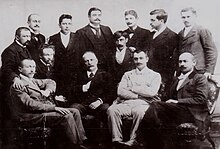Simo Matavulj | |
|---|---|
 | |
| Born | 14 September 1852 Šibenik, Kingdom of Dalmatia, Austrian Empire |
| Died | 20 February 1908 (aged 55) Belgrade, Kingdom of Serbia |
| Occupation | Novelist |
| Language | Serbian |
| Period | Realism |
| Genre | Satire |
| Subject | Dalmatian people |
| Notable works | Bakonja fra-Brne, Pilipenda, Biljeske Jednog Pisca |
Simo Matavulj (Serbian: Симо Матавуљ, 14 September 1852 – 20 February 1908) was a Serbian writer.[1]
He was a representative of lyric realism, especially in short prose. As a writer, he is best known for employing his skill in holding up to ridicule the peculiar foibles of the Dalmatian folk.
He was an honorary member of the Matica srpska of Novi Sad, the first president of the Association of Writers of Serbia, president of the Society of Artists of Serbia and a member of the Serbian Royal Academy.

Legacy[edit]
Nobel prize winner Ivo Andrić called him "the master storyteller".[2]
Works[edit]
- Noć uoči Ivanje, Zadar, 1873.
- Naši prosjaci, Zadar, 1881.
- Iz Crne Gore i Primorja I, Novi Sad, 1888.
- Iz Crne Gore i Primorja II, Cetinje, 1889.
- Novo oružje, Belgrade, 1890.
- Iz prіmorskog žіvota, Zagreb, 1890.
- Sa Jadrana, Belgrade, 1891.
- Iz beogradskog života, Belgrade, 1891.
- Bakonja fra-Brne, Belgrade, 1892.
- Uskok, Belgrade, 1893.
- Iz raznijeh krajeva, Mostar, 1893.
- Boka i Bokelji, Novi Sad, 1893.
- Primorska obličja, Novi Sad, 1899.
- Deset godina u Mavritaniji, Belgrade, 1899.
- Tri pripovetke, Mostar, 1899.
- Na pragu drugog života, Sremski Karlovci, 1899.
- S mora i planine, Novi Sad, 1901.
- Beogradske priče, Belgrade, 1902.
- Pošljednji vitezovi i Svrzimantija, Mostar, 1903.
- Život, Belgrade 1904.
- Na slavi, Belgrade, 1904.
- Zavjet, Belgrade, 1904.
- Car Duklijan, Mostar, 1906.
- Nemirne duše, Belgrade, 1908.
- Bilješke jednoga pisca, Belgrade, 1923.
- Golub Dobrašinović
Translations[edit]
- Na vodi by Guy de Maupassant, 1893.
- Vilina knjiga, a collection of fairy tales, 1894.
- Bleak House by Charles Dickens 1893.
- Zimske priče by M. de Vogie, 1894.
- The dream by Émile Zola
- Pučanin kao vlastelin by Moliere, 1906.
- The Misanthrope by Moliere,
- The Imitation of Christ by Thomas à Kempis, unpublished during Matavulj's lifetime
References[edit]
- ^ "Родослов породице Матавуљ из Шибеника". Порекло (in Serbian). 29 October 2019. Retrieved 4 January 2021.
- ^ "[Projekat Rastko] Simo Matavulj: Pripovetke".
- Translated and adapted from Jovan Skerlić's Istorija nove srpske književnosti / History of New Serbian Literature (Belgrade, 1921), pp. 390–395.
External links[edit]
- (in Serbian) Extensive biography

Well, that’s interesting to know that Psilotum nudum are known as whisk ferns. Psilotum nudum is the commoner species of the two. While the P. flaccidum is a rare species and is found in the tropical islands. Both the species are usually epiphytic in habit and grow upon tree ferns. These species may also be terrestrial and grow in humus or in the crevices of the rocks.
View the detailed Guide of Psilotum nudum: Detailed Study Of Psilotum Nudum (Whisk Fern), Classification, Anatomy, Reproduction